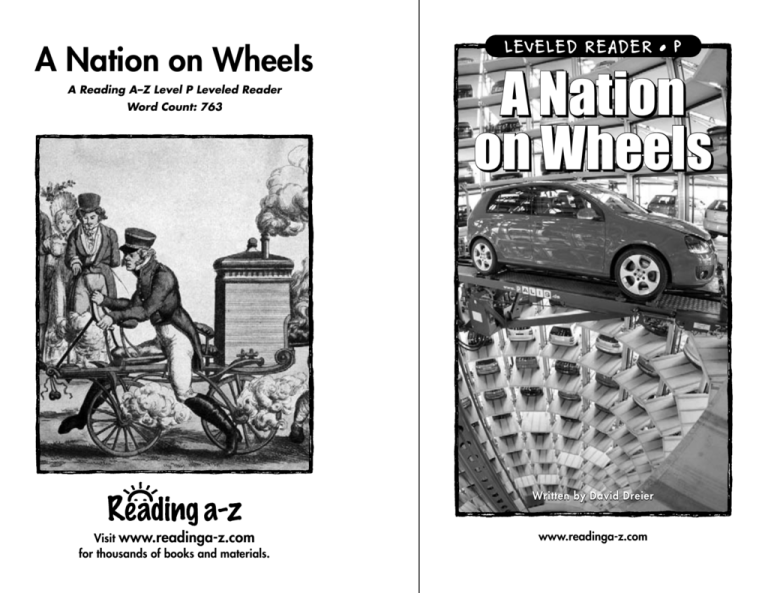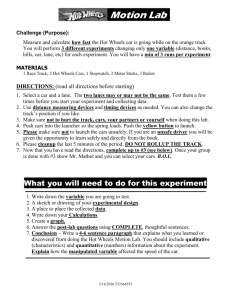
A Nation on Wheels
A Reading A–Z Level P Leveled Reader
Word Count: 763
LEVELED READER • P
A Nation
on Wheels
Written by David Dreier
Visit www.readinga-z.com
for thousands of books and materials.
www.readinga-z.com
A Nation
on Wheels
Written by David Dreier
Photo Credits:
Front cover: © Rainer Jensen/dpa/Corbis; back cover: © Mary Evans Picture
Library; title page: © Denis Vorob’yev/iStockphoto Inc; page 3: © Reed Kaestner/
Corbis; page 4: © Will & Deni McIntyre/CORBIS; page 5 (right): © ALISON
WRIGHT/National Geographic Images; page 5 (left): © Galen Rowell/CORBIS;
page 6: © The Granger Collection, New York; page 7: Photo by Library of
Congress/Hulton Archive/Getty Images; page 8: © AP Images/Ford Motor Co.;
page 9: (top): © Hulton Archive/Getty Images; page 9 (middle): © Car Culture/
Getty Images; page 9 (bottom): © Motoring Picture Library/Alamy; page 10 (top):
Jupiterimages Corporation; page 10 (bottom): © Patrick Zachmann/Magnum
Photos; page 12 (all): Craig Frederick/© Learning A–Z; page 13: © Alexander
Ruesche/epa/Corbis; page 14: © Don Johnston/Stone Collection/Getty Images;
page 15: © Kim Kulish/Corbis
A Nation on Wheels
Level P Leveled Reader
© Learning A–Z, Inc.
Written by David Dreier
All rights reserved.
www.readinga-z.com
www.readinga-z.com
Correlation
LEVEL P
Fountas & Pinnell
Reading Recovery
DRA
N
21
30
Table of Contents
Introduction . . . . . . . . . . . . . . . . . . . . . . . . 4
New York City traffic
The Early Days . . . . . . . . . . . . . . . . . . . . . . 5
Introduction
How Cars Are Made . . . . . . . . . . . . . . . . . 7
The world is full of cars and trucks. There
are over 600 million of them! They are in
even the smallest town in the smallest
country. There are over 200 million cars
and trucks just in the United States. Most
of these vehicles are automobiles. We are
a nation moving on wheels!
Companies That Make Cars . . . . . . . . . . 11
Problems Caused by the Automobile . . 13
The Future of the Automobile . . . . . . . . 14
Glossary . . . . . . . . . . . . . . . . . . . . . . . . . . . 16
3
4
The Early Days
People have always needed to travel.
At first, people walked everywhere—
even long distances. Then they tamed
animals to ride and taught some to
pull wagons. Horses, camels, and even
elephants helped people make trips
and carry things. Imagine riding to school
on an elephant! Using animals was better
than walking—but it was still slow.
Inventors tried to build a machine with
wheels to carry people faster. They
thought of building an engine to run it.
They tried running engines with steam
or with electricity. But neither engine
worked well enough. In the late 1880s,
people made engines that could run on
gasoline, or gas. These engines were
small but powerful. They could travel
faster and go farther. Today, most cars
use gas engines.
Elephants in India
help carry people
and goods still today.
steam
engine
steering
driver’s
seat
three wheels
One of the first steam vehicles, built in 1770
Do You Know?
Which word came first—car or automobile? Car
was first used in 1301 to describe a Celtic war chariot.
Automobile was first used by a Frenchman in 1883 to
describe electric cars. How are they used now?
A Camel taxi takes
people where they want
to go in India, too.
5
6
Carmaker Henry
Ford sits in the
first car he made
in 1896.
How Cars Are Made
The first cars did not look like the ones
you see today. They looked like carriages
without horses. People even called them
horseless carriages!
Henry Ford’s company made more than 15 million Model Ts over
almost twenty years.
At first, cars were made one at a time
by hand. It took a long time. They were
expensive. Not everyone could afford
a handmade car. People tried ways to
manufacture cars faster and at a lower
cost. In 1896, one early company could
make only 13 cars in a year. But by 1899,
a company could make over 2,000!
In 1903, Henry Ford started the Ford
Motor Company in Detroit, Michigan.
Detroit would soon become the center
of car making. Ford’s company sold a
car called the Model T. Ford wanted to
make cars that cost less—so more people
could buy them. This meant he had to
manufacture more cars and do it faster.
7
8
Ford thought about all the ways he
could do this. In 1913, he invented the
assembly line. It was a faster and
cheaper way to make a car. Soon, other
companies made their cars this way.
Now almost everyone could buy a car.
By 1929, over 3.5 million cars were on
the road. There were so many cars that
people had to build more roads!
What Is an Assembly Line?
1940 Chrysler
Royal Sedan
On an assembly line, a car is assembled—put
together—one piece at a time. Machines pull unfinished
cars through the factory in a long line. As each car
moves along the line, parts are added to it. At the end
of the line, the car is complete.
For years, people did all the work on an assembly
line. But today, machines called robots often do this
work. These
robots are not
like the ones in
movies. These are
special machines
that work the
same way that
an arm and hand
work. Robots
can work without
getting tired.
One of the earliest assembly lines
1957
Chevrolet
Bel Air
1965 Ford
Thunderbird
A modern assembly line
9
10
Companies That Make Cars
U.S. Carmakers and Brands in 2007
Three big companies have been making
cars in the United States for a long time:
General Motors, Chrysler, and Ford.
Since cars first hit the streets, American
companies have led the world in car
production. In the 1960s and ’70s, a
Japanese company named Toyota began
offering cars that were built to last longer
and break down less often than most
American-made cars. But the American
car manufacturers still sold the most cars.
Then in 2007 the pattern changed.
Toyota, the first foreign company to do
so, sold more cars and trucks than any
other company in the world.
Cadillac
Hummer
Pontiac
General
Motors
Saturn
Buick
Saab
Chrysler makes
the Chrysler,
Dodge, and Jeep.
Ford makes the
Ford, Lincoln,
Mercury, Mazda
and Volvo.
GMC
Some Foreign Carmakers and Brands in 2007
BMW makes the
BMW, MINI, and
Rolls-Royce.
Toyota
Daihatsu
Scion
Toyota
Toyotas are not the only cars made outside
the United States. The Volkswagen and
BMW are imported from Germany. But
the countries of Japan and South Korea
have brought the highest numbers of cars
into the United States.
11
Chevrolet
Volkswagen
makes the Audi,
Bentley, Bugatti,
Lamborghini,
Skoda, and SEAT.
Honda makes the
Honda and Acura.
Nissan makes the
Nissan and Infiniti.
Hino
Lexus
Hyundai
Kia
12
Problems Caused by the Automobile
The Future of the Automobile
Automobiles are helpful, but they can
also cause serious problems for people.
Exhaust (burning gases from a car’s
tailpipe) gets in the air. That means
unhealthy chemicals get in the air that
we breathe. These
chemicals can make
people sick. Every
year car companies
try to reduce the
amount of chemicals their cars make.
Have you ever been in a traffic jam?
All the cars on the road just sat still,
and you couldn’t go anywhere. So many
cars are on the road today that it causes
problems. Remember—there are about
200 million cars in the United States.
That’s almost as many cars as people.
In fact, the number of cars has grown
faster than the number of people.
13
Years ago, most cars were unsafe in
accidents. Today, special car parts help
to protect people. Cars have seat belts.
Babies and small children ride in safety
seats. Newer cars have big airbags that
inflate—
fill with
air—in
accidents.
What do
you think
would
make cars
Carmakers see how well airbags work by
using crash test dummies that look like humans. even safer?
Car companies are also working on new
kinds of engines. One type of car, called
a hybrid, uses both a gas engine and an
electric motor. Hybrids use less gas.
This might cut down on the unhealthy
chemicals in the air.
14
Glossary
automobiles
vehicles with four wheels that
have an engine and travel on
roads (p. 4)
chemicals (n.)
substances that are produced by
or used in a chemical process
(p. 13)
distances (n.)
the amounts of space between
things or places (p. 5)
engine (n.)
a machine with moving parts
that uses power to create motion
(p. 6)
expensive (adj.) costly; having a high price (p. 7)
A company called ZAP made these electric cars to help cut down
on bad chemicals in the air.
We will always be a nation that travels
from one place to another. But will it
always be on wheels? How will cars
look in the future? How will they work?
Perhaps your ideas will shape the future.
15
foreign (adj.)
of or from a different country or
language (p. 11)
imported (v.)
to have brought in and bought
goods from another country or
state (p. 11)
inventors (n.)
people who invent or create new
products (p. 6)
manufacture (v.) to make finished goods,
especially using industry (p. 7)
production (n.) the process of combining
resources to make a product for
sale (p. 11)
16








